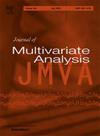多元正态曲线对角变换后的精确均值和协方差公式
IF 1.4
3区 数学
Q2 STATISTICS & PROBABILITY
引用次数: 0
摘要
考虑X∼N(0,Σ)和Y = (f1 (X1)、f2 (X2),…,fd (Xd))。我们称它为多元正态线的对角变换。在本文中,我们精确地计算随机向量y的均值向量和协方差矩阵。这是通过两种不同的方式完成的:一种方法使用函数fi的级数展开,另一种方法使用变换方法。我们计算了几个例子,说明了如何估计协方差项,并将理论结果与数值结果进行了比较。本文章由计算机程序翻译,如有差异,请以英文原文为准。
Exact mean and covariance formulas after diagonal transformations of a multivariate normal
Consider and . We call this a diagonal transformation of a multivariate normal. In this paper we compute exactly the mean vector and covariance matrix of the random vector This is done in two different ways: One approach uses a series expansion for the function and the other a transform method. We compute several examples, show how the covariance entries can be estimated, and compare the theoretical results with numerical ones.
求助全文
通过发布文献求助,成功后即可免费获取论文全文。
去求助
来源期刊

Journal of Multivariate Analysis
数学-统计学与概率论
CiteScore
2.40
自引率
25.00%
发文量
108
审稿时长
74 days
期刊介绍:
Founded in 1971, the Journal of Multivariate Analysis (JMVA) is the central venue for the publication of new, relevant methodology and particularly innovative applications pertaining to the analysis and interpretation of multidimensional data.
The journal welcomes contributions to all aspects of multivariate data analysis and modeling, including cluster analysis, discriminant analysis, factor analysis, and multidimensional continuous or discrete distribution theory. Topics of current interest include, but are not limited to, inferential aspects of
Copula modeling
Functional data analysis
Graphical modeling
High-dimensional data analysis
Image analysis
Multivariate extreme-value theory
Sparse modeling
Spatial statistics.
 求助内容:
求助内容: 应助结果提醒方式:
应助结果提醒方式:


